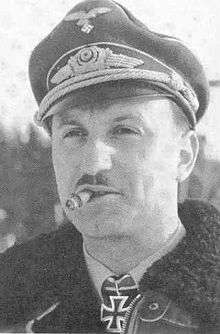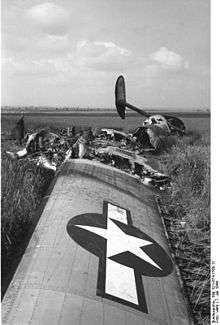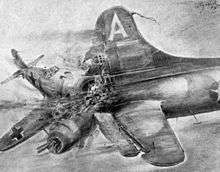Walther Dahl
| Walther Dahl | |
|---|---|
 Walther Dahl | |
| Nickname(s) | Rammdahl |
| Born |
27 March 1916 Lug near Bad Bergzabern |
| Died |
25 November 1985 (aged 69) Heidelberg |
| Buried at |
Heidelberg, Bergfriedhof Field T—Grave 6 |
| Allegiance |
|
| Service/branch |
|
| Years of service | 1935–45 |
| Rank | Oberst |
| Unit | JG 3, JG 300, EJG 2 |
| Commands held | III./JG 3, JG 300 |
| Battles/wars |
World War II |
| Awards | Knight's Cross of the Iron Cross with Oak Leaves |
Walther Dahl (27 March 1916 – 25 November 1985) was a German Luftwaffe officer and a fighter ace. He was a recipient of the Knight's Cross of the Iron Cross with Oak Leaves during World War II. The Knight's Cross of the Iron Cross and its higher grade Oak Leaves was awarded by Nazi Germany to recognise extreme battlefield bravery or successful military leadership. A flying ace or fighter ace is a military aviator credited with shooting down five or more enemy aircraft during aerial combat.[1] Dahl claimed some 128 enemy aircraft shot down in 678 missions, including about 300 ground-attack missions.[2]
Early life and career
Dahl was born on 27 March 1916 in Lug near Bad Bergzabern, son of a school teacher who was killed in action in 1918 in World War I. Dahl joined the military service in October 1935, initially serving with an infantry regiment before transferring to Infantrie-Regiment 119 in Stuttgart on 6 October 1936. On 18 January 1938, Dahl was promoted to Leutnant (second lieutenant) of the Reserves with an effective date as of 1 January 1938.[3]
In October 1938, Dahl quit his service with the Heer (army) and joined the Schutzpolizei (police) on 29 October 1938. In May 1939, Dahl resigned and joined the Luftwaffe (air force) becoming a fighter pilot.[3]
World War II

By May 1941 Dahl was part of the Geschwaderstab (headquarters unit) of Jagdgeschwader 3 (JG 3—3rd Fighter Wing) and claimed his first victory on 22 June during the first day of the invasion of the Soviet Union. In July Dahl transferred to II. Gruppe of JG 3. By the end of October Dahl had 17 claims. He was then transferred to 4 staffel, JG 3 in December 1941 before the unit was posted to the Mediterranean theatre. He claimed a Spitfire over Malta on 1 April 1942 and on 10 April 1942 Dahl was made Staffelkapitän, Ergänzungsgruppe, JG 3.
In April 1943, Dahl was transferred to the staff of the General der Jagdflieger. In August, Dahl was next appointed Geschwaderadjutant, JG 3 on the Eastern Front where he had raised his total to 51, being awarded the German Cross in Gold (Deutsches Kreuz in Gold) in December 1942
On 20 July 1943, Dahl was posted as Gruppenkommandeur III./JG 3 and relocated to Münster from Kursk. He claimed 2 four-engined bombers on 6 September and 2 more four-engined bombers (and a P-38) on 23 February 1944.
Dahl led a III./JG 3 formation against the Schweinfurt and Regensburg raid of 17 August 1943 but was intercepted by Spitfires of No. 222 Squadron. III./JG 3 lost 5 Bf 109s shot down including Dahl who had to make a belly landing in his Bf 109 G-6. Major Dahl was awarded the Knight's Cross of the Iron Cross (Ritterkreuz des Eisernen Kreuzes) in March 1944 for 67 victories.
Wing commander

On 21 May 1944, Dahl was appointed Geschwaderkommodore (wing commander) of Jagdgeschwader zur besonderen Verwendung (JG z.b.V.—a special purpose fighter wing). He led the unit until taking command of Jagdgeschwader 300 (JG 300—300th Fighter Wing) on 27 June 1944. Dahl set up his Geschwaderstab (headquarters unit) at Ansbach, planning combined operations with JG 3 "Udet".[4] JG 300 was to become famous for flying the heavily armed and armored Focke Wulf FW 190A-8 "Sturmbock" in close formation, driving in their attacks to point-blank range. As a last resort, after depletion of all ammunition, the pilots had to ram enemy bombers.
On 7 July 1944, a force of 1,129 B-17 Flying Fortresses and B-24 Liberators of the United States Army Air Forces (USAAF) Eighth Air Force set out from England to bomb aircraft factories in the Leipzig area and the synthetic oil plants at Boehlen, Leuna-Merseburg and Lützkendorf. This force was divided into three prongs. The first group consisted of 373 B-24s, the second force of the 3rd Bomb Division was made up of 303 B-17s, and the third wave was made up of 450 B-17s. A series of accidents at the start of the mission allowed the Luftwaffe to focus their attacks on the B-24 force.[5] This formation was intercepted by a German Gefechtsverband consisting of IV.(Sturm) Gruppe Jagdgeschwader 3 escorted by two Gruppen of Bf 109s from JG 300 led by Dahl. Dahl drove the attack to point-blank range behind the Liberators of the 492nd Bomb Group before opening fire. 492nd Bomb Group was temporarily without fighter cover. Within about a minute the entire squadron of twelve B-24s had been annihilated. The Germans claimed 28 USAAF 2nd Air Division B-24s that day and were credited with at least 21.[6] The majority to the Sturmgruppe attack. IV./JG 3 lost nine fighters shot down and three more suffered damage and made crash landings; five of the unit's pilots were killed.[7][8] On this mission, Dahl was credited with his 72nd aerial victory, a B-24 shot down in the vicinity of Quedlinburg.[9]

On 13 September, Dahl claimed to have brought down a B-17 four-engined bomber by ramming according to his own account. Lorant and Goyat, the historians of JG 300, found no evidence of a corresponding loss in US archives.[10]
For his personal exploits and that of his unit, Dahl was dubbed Rammdahl again according to his own account. On the morning of 30 November 1944, Dahl was informed that Reichsmarschall Hermann Göring was coming to visit the troops and to present Dahl with the Oak Leaves to the Knight's Cross. At 12:20 pm Göring and Generaloberst Bruno Loerzer arrived and Dahl made a formal report. Soon the discussion came to the question of whether Dahl believed that given these bad weather conditions the Geschwader could not engage in combat. Dahl explained that in only good conditions would they stand a chance against the overwhelming odds, as they were outnumbered 20:1. He also referred to the inexperience and inadequate training of his young pilots. Into this situation came the news of an approaching bomber formation. Göring ordered Dahl to take off and engage the enemy. Dahl stood his ground and continuously refused to obey. Göring became furious and threatened Dahl with court martial and execution. Only the arriving General Adolf Galland, who confirmed Dahl's opinion, saved Dahl from severe punishment. Nevertheless, Dahl was immediately relieved from his command and sent on sick leave. Subsequently, Dahl was not presented with the Oak Leaves that day.[11]
On 26 January 1945, Hermann Göring appointed him Inspekteur der Tagjäger (Inspector of the Day Fighters). Despite his promotion, Dahl continued to fly operationally. On 28 February 1945, Dahl was credited with his 100th aerial victory. He was the 98th Luftwaffe pilot to achieve the century mark.[12]
Dahl ended the war flying the Messerschmitt Me 262 jet fighter with III./Ergänzungs-Jagdgeschwader 2 (a supplementary fighter unit). On 27 March 1945,[13] Dahl claimed two P-47 Thunderbolt fighter kills.[14] His 129th and last victory was a USAAF P-51 Mustang near Dillingen an der Donau on 26 April 1945. Dahl was promoted to Oberst (colonel) on 30 April 1945. He was taken prisoner of war by US forces in Bavaria at the end of World War II in Europe.[13]
Post World War II
Following the war, Dahl became a member of the Deutsche Reichspartei (DRP—German Reich Party)[15] In the West German federal election of 1961 he unsuccessfully ran as a candidate for the DRP.[16] On 8 May 1961, Dahl founded the "Reichsverband der Soldaten" (lit. "Reich Association of Soldiers").[17] Dahl was married to Regina Dahl, a journalist with the National Zeitung, a weekly extreme right newspaper published by Gerhard Frey. Dahl was a spokesman for the German People's Union, a nationalist political party founded by Frey. In 2004, Frey and Hajo Herrmann published an abstract of Dahl's biography in the book Helden der Wehrmacht – Unsterbliche deutsche Soldaten [Heroes of the Wehrmacht – Immortal German soldiers]. This publication was classified as a far-right wing publication by Claudia Fröhlich and Horst-Alfred Heinrich.[18] Dahl died on 25 November 1985 of heart failure in Heidelberg.[13]
Works
- Rammjäger: Bericht über seine Kriegserlebnisse 1943 bis 1945 (in German). Pour le Mérite Verlag ISBN 3-932381-01-7 (2000).
Awards
- Iron Cross (1939) 2nd and 1st class
- Ehrenpokal der Luftwaffe (23 December 1941)[19]
- German Cross in Gold on 2 December 1942 as Oberleutnant in the Stab/JG 3[20]
- Knight's Cross of the Iron Cross with Oak Leaves
- Knight's Cross on 11 March 1944 as Major and Gruppenkommandeur of the III./JG 3 "Udet"[21]
- 724th Oak Leaves on 1 February 1945 as Major and Geschwaderkommodore of JG 300[21]
- Mentioned in the Wehrmachtbericht on 8 July 1944
References
Citations
- ↑ Spick 1996, pp. 3–4.
- ↑ Spick 1996, p. 230.
- 1 2 Stockert 2008, p. 40.
- ↑ Lorant & Goyat 2005, p. 206.
- ↑ Lorant & Goyat 2005, p. 211.
- ↑ Caldwell & Muller 2007, p. 216.
- ↑ Dahl 2000, pp. 46–66
- ↑ Weal 1996, p. 78.
- ↑ Lorant & Goyat 2005, p. 213.
- ↑ Lorant & Goyat 2005, p. 325.
- ↑ Dahl 2000, p. 154–165
- ↑ Obermaier 1989, p. 243.
- 1 2 3 Stockert 2008, p. 43.
- ↑ Morgan & Weal 1998, p. 21.
- ↑ Jenke 1967, p. 128.
- ↑ Frederik 1966, p. 161.
- ↑ Jaschke 2013, p. 90.
- ↑ Fröhlich & Heinrich 2004, p. 134.
- ↑ Obermaier 1989, p. 72.
- ↑ Patzwall & Scherzer 2001, p. 77.
- 1 2 Scherzer 2007, p. 264.
Bibliography
- Caldwell, Donald; Muller, Richard (2007), The Luftwaffe Over Germany: Defense of the Reich, MBI Publishing Company, ISBN 978-1-85367-712-0
- Fröhlich, Claudia; Heinrich, Horst-Alfred (2004). Geschichtspolitik: Wer sind ihre Akteure, wer ihre Rezipienten? [Political History: Who are their Players, who their Recipients?] (in German). Stuttgart, Germany: Franz Steiner Verlag. ISBN 978-3-515-08246-4.
- Frederik, Hans (1966). NPD. Gefahr von rechts? (in German). München-Inning, Germany: Verlag Politisches Archiv. ASIN B0000BSV71.
- Jaschke, Hans-Gerd (2013). Entstehung und Entwicklung des Rechtsextremismus in der Bundesrepublik: Zur Tradition einer besonderen politischen Kultur [Creation and Development of Right-Wing Extremism in the Federal Republic: the Tradition of a Particular Political Culture] (in German). Wiesbaden, Germany: Springer-Verlag. ISBN 978-3-322-99709-8.
- Jenke, Manfred (1967). Die nationale Rechte. Parteien, Politiker, Publizisten (in German). Frankfurt am Main, Germany: Büchergilde Gutenberg. ASIN B0024N8QEI.
- Lorant, Jean Yves; Goyat, Richard (2005). Jagdgeschwader 300 "Wilde Sau" — Volume One: June 1943 – September 1944. Hamilton, Montana: Eagle Edition. ISBN 978-0-9761034-0-0.
- Morgan, Hugh; Weal, John (1998). German Jet Aces of World War 2. London; New York: Osprey Publishing. ISBN 978-1-85532-634-7.
- Obermaier, Ernst (1989). Die Ritterkreuzträger der Luftwaffe Jagdflieger 1939 – 1945 [The Knight's Cross Bearers of the Luftwaffe Fighter Force 1939 – 1945] (in German). Mainz, Germany: Verlag Dieter Hoffmann. ISBN 978-3-87341-065-7.
- Patzwall, Klaus D.; Scherzer, Veit (2001). Das Deutsche Kreuz 1941 – 1945 Geschichte und Inhaber Band II [The German Cross 1941 – 1945 History and Recipients Volume 2] (in German). Norderstedt, Germany: Verlag Klaus D. Patzwall. ISBN 978-3-931533-45-8.
- Prien, Jochen; Stemmer, Gerhard (2002). Jagdgeschwader 3 "Udet" in WWII: Stab and I./JG 3 in Action with the Messerschmitt Bf 109. Atglen, Pennsylvania: Schiffer Military History. ISBN 978-0-7643-1681-4.
- Scherzer, Veit (2007). Die Ritterkreuzträger 1939–1945 Die Inhaber des Ritterkreuzes des Eisernen Kreuzes 1939 von Heer, Luftwaffe, Kriegsmarine, Waffen-SS, Volkssturm sowie mit Deutschland verbündeter Streitkräfte nach den Unterlagen des Bundesarchives [The Knight's Cross Bearers 1939–1945 The Holders of the Knight's Cross of the Iron Cross 1939 by Army, Air Force, Navy, Waffen-SS, Volkssturm and Allied Forces with Germany According to the Documents of the Federal Archives] (in German). Jena, Germany: Scherzers Militaer-Verlag. ISBN 978-3-938845-17-2.
- Spick, Mike (1996). Luftwaffe Fighter Aces. New York: Ivy Books. ISBN 978-0-8041-1696-1.
- Stockert, Peter (2008). Die Eichenlaubträger 1939–1945 Band 8 [The Oak Leaves Bearers 1939–1945 Volume 8] (in German). Bad Friedrichshall, Germany: Friedrichshaller Rundblick. OCLC 76072662.
- Thomas, Franz (1997). Die Eichenlaubträger 1939–1945 Band 1: A–K [The Oak Leaves Bearers 1939–1945 Volume 1: A–K] (in German). Osnabrück, Germany: Biblio-Verlag. ISBN 978-3-7648-2299-6.
- Weal, John (1996). Focke-Wulf Fw 190 Aces of the Western Front. Oxford, UK: Osprey Publishing. ISBN 978-1-85532-595-1.
- Die Wehrmachtberichte 1939-1945 Band 3, 1. Januar 1944 bis 9. Mai 1945 [The Wehrmacht Reports 1939–1945 Volume 3, 1 January 1944 to 9 May 1945] (in German). München, Germany: Deutscher Taschenbuch Verlag GmbH & Co. KG. 1985. ISBN 978-3-423-05944-2.
External links
- Walther Dahl in the German National Library catalogue
- "Walther Dahl". Walther Dahl - his aircraft and his (inflated) claims. Retrieved 12 December 2012.
| Military offices | ||
|---|---|---|
| Preceded by Major Gerhard Michalski |
Commander of Jagdgeschwader z.b.V. 20 May 1944 – 6 June 1944 |
Succeeded by Major Gerhard Schöpfel |
| Preceded by Oberstleutnant Kurd Kettner |
Commander of Jagdgeschwader 300 27 June 1944 – 26 January 1945 |
Succeeded by Major Kurd Peters |
